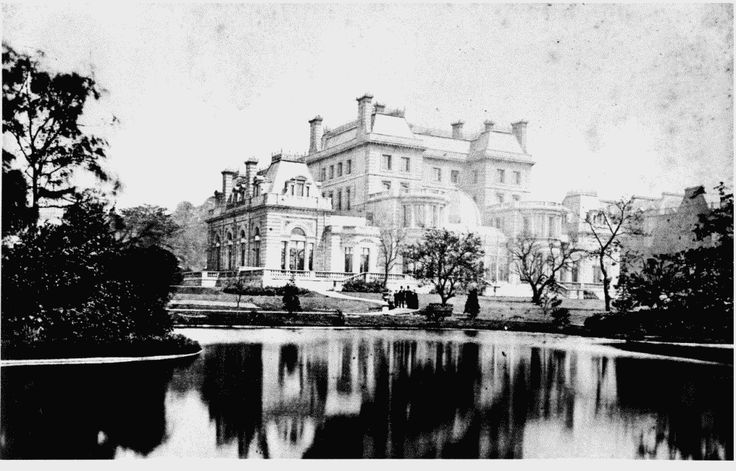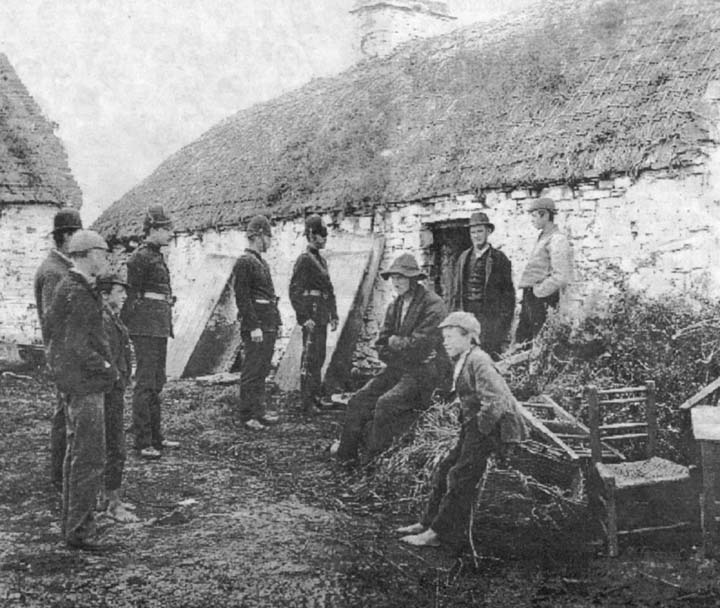A London slum: Irish migration and its threat
Jennings’ Buildings was known locally as the ‘Irish Rookery’ (a contemporary name for a criminal area). It stood until 1873 on Kensington High Street, an area of London noted for its fine houses and aristocratic inhabitants. Kensington Palace, birthplace of Queen Victoria, stood opposite. The ‘miserable and ill-ventilated’ huts of this slum were in sharp contrast to its affluent surroundings.
A London slum in Kensington
Nineteenth-century Irish migration
An image of an Irish eviction by police
The threat of the ‘Irish Rookery’
The male migrants of Jennings’ Buildings found work in Kensington helping to construct housing for this rapidly expanding area of middle-class London. They also worked as fruit pickers in surrounding orchards. Many of the women worked as laundresses, cleaning the clothes of their wealthy neighbours. Such work was not always reliable and some had to depend upon local government poor relief, often in the Kensington workhouse, when work was not forthcoming. A few turned to petty crime.
Despite their hard work and their contribution to the Kensington economy, including paying high rents for their slum dwellings, for the most part the inhabitants of the Buildings were seen as outsiders. This was not only because they were Catholics in a Protestant country but also because the Irish working class, generally, was believed not to share respectable British values. If they drank and found recreation on the streets of Kensington this was widely viewed as a moral failing of Irish migrants rather than a result of their having no room in their homes to seek relaxation as did the more wealthy. If this made them more vulnerable to arrest for public order offences this was frequently viewed as proof that they shared a criminal culture. The local newspaper, the Kensington Gazette, wrote in 1855: ‘in the heart of town there has been an acre long desecrated as the haunt of poverty and disease, dirt and crime. To point out a spot of equal social deformity is difficult—to discover one worse is impossible.’
In 1873, the local Medical Officer reported that the slum’s lack of lavatories was actually ‘an advantage, regard being had to the character of residents.’ Indeed, he believed that the ‘difficulty was in getting the inhabitants to use them as ordinary persons would.’ He concluded, ‘Altogether the “Buildings” were well looked after, and if they were objectionable, it was by reason both of the bad class of houses, for which the present generation is not responsible, and the habits of the people who inhabited them…’. By finding the Buildings’ inhabitants largely responsible for their own misfortune, the medical examiner was simply echoing widely held views that the Irish poor in general were undeserving of help. In other words, their misery was believed to be brought on by their own failings rather than any material misfortune that might have befallen them.
In all, the presence of Jennings’ Buildings with its population of Irish immigrants and their descendants was viewed by many to pose the threat of bringing disease, disorder and criminal activity to respectable Kensington. The threat which Jennings’ Building was thought to pose is summarised by this quote from the West London Observer newspaper:
‘The inhabitants consist chiefly of the lower order of Irish… They are continually creating disturbances, assaulting the police, and by their violent and disgraceful habits the inhabitants of Kensington are continually kept in fear of some outrage. They are, in fact, the terror of the neighbourhood.’
From slum to grand house
In 1873, a wealthy individual, Albert Grant, also an Irish migrant but a banker and a friend of royalty, bought the Buildings from its highly respectable, local owners. Grant bought the Buildings in order to demolish them and make way for the construction of Kensington House, which was, on completion, the most expensive house in London. The former residents moved out into other London slums and ten years later Albert Grant went bankrupt and died in relative poverty.
Kensington House, whose grandeur can be seen in the picture below, was itself demolished in its turn.

Image courtesy of the Royal Borough of Kensington and Chelsea Archive
- Irish people in the nineteenth century were often stereotyped as poor, lazy and unhygienic (see: ‘The Irish in early industrial Britain’). At first glance, the story of Jennings’ Buildings seems to support these ideas. Look again at the information above. What aspects of Irish experience in Jennings’ Building goes against the stereotypes of the time?
- What role did religion play in reactions to Irish migrants?
- In 1873, Kensington's local Medical Officer came to the conclusion that Jennings’ Buildings’ inhabitants were ‘largely responsible for their own misfortune’. Were they? Whom do you think was to blame?








